IN THIS ISSUE
- Steering clear of terrapins
- Help map wading bird rookeries
- Prescribed fire: less risk, less smoke
- A backyard bird you've likely overlooked
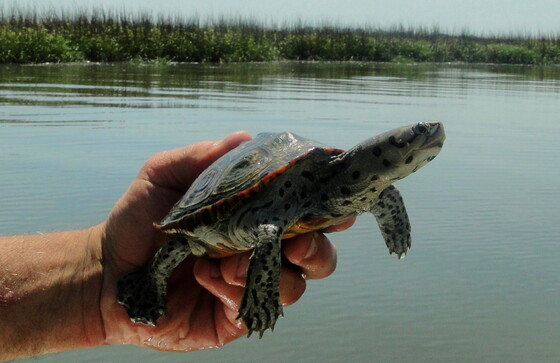 Near Tybee and Jekyll islands, drivers urged to watch for terrapins (Rick Lavender/DNR)
While nesting sea turtles are making headlines, nesting diamondback terrapins are lighting up road signs.
The nesting season for loggerhead sea turtles in Georgia began May 1, with the first nest found on Blackbeard Island National Wildlife Refuge.
The same day near Tybee Island, two message boards along the Tybee causeway (U.S. 80) started flashing warnings for drivers to keep an eye out for diamondback terrapins crossing the busy highway.
From May until mid-July, for up to two hours before and after daily high tides these saltmarsh turtles with the lipstick mouths crawl for higher ground to lay their eggs. The roadsides of U.S. 80, which bisects marsh between the Bull River and the Savannah River’s South Channel, are a magnet for adult females.
The Georgia Department of Transportation runs alternating messages on the causeway during the nesting period, with timing synced to a tide gauge at nearby Fort Pulaski National Monument. DOT Ecology Section manager Chris Goodson said one script tells drivers to watch for turtles. The other cautions against following too close.
“The first is awareness about possible wildlife on the roadway,” Goodson said. “The second, typically it’s not the car out in front (that hits the terrapin), but the one following too closely behind. The second message is really about if you provide space, you’re more likely to avoid it.”
DNR Sea Turtle Program Coordinator Mark Dodd said the use of flashing turtle-crossing signs along the Jekyll Island Causeway, another diamondback terrapin nesting hotspot, contributed to significantly fewer road-killed terps. “A scientific study showed that it really does reduce mortality.”
The hope is the Tybee signs – along other efforts at Jekyll and elsewhere – continue to help drivers steer clear of these declining turtles, a high-priority species in Georgia’s State Wildlife Action Plan.
FOR MORE
 Tricolored heron is one of the species targeted in the Coastal Plain nest survey. (Shirley Robinson/GNPA)
For the first time in almost 30 years, DNR is taking a Coastal Plain-wide look at nesting colonies of wading birds. And the public’s help is not only welcomed, it’s needed.
According to wildlife biologist Tim Keyes, the survey is important on two fronts: providing details on Georgia rookery sites, sizes and species, and plugging into a larger conservation effort to coordinate monitoring of colonial waterbirds across the Atlantic Flyway.
“It’s critical to understanding species populations and population trends,” Keyes said.
DNR already surveys the nesting of federally-listed wood storks each year and has a good grasp on seabird nest colonies in Georgia. But wading birds, all part of the larger group called colonial waterbirds (colonial refers to nesting in colonies or groups), are more of an unknown. The state’s last survey was in 1996. Now waders such as tricolored and little blue herons are species of concern in Georgia's State Wildlife Action Plan, for reasons varying from declining numbers to limited data on how they’re doing.
Keyes said the 2023 survey, which serves as a pilot run and includes transects flown by plane, will be repeated and expanded in 2024.
Georgians can help this spring by reporting wading bird rookeries in the Coastal Plain. The region encompasses the state below the Fall Line, which runs roughly from Columbus to Macon then Augusta.
The survey covers location, species, estimated number of nests and whether the site is on public or private land. Keyes stressed that the target is confirmed nesting sites – where birds are incubating eggs, brooding young or feeding chicks – not where wading birds are only roosting. Colonies should be observed without disturbing the birds. All wading bird species are protected by federal and state law.
The nesting season runs from about mid-March into July. Most nest colonies will be over or near water, although black- and yellow-crowned night herons sometimes nest in forest canopies.
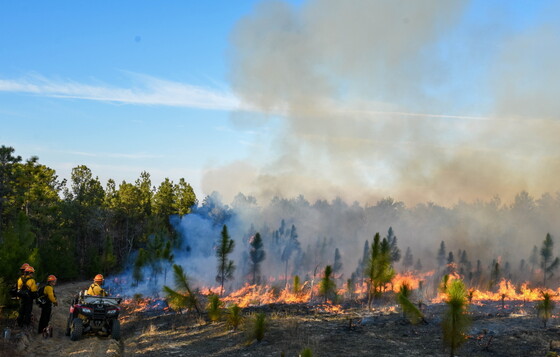 DNR staff monitor a prescribed fire at Sandhills WMA West (Hal Massie/DNR)
With prescribed burns occurring across the state and close on the heels of Air Quality Awareness Week, the sight of smoke columns may have some people wondering about the health effects of wildland smoke. One key is whether the smoke is from a wildfire or a prescribed fire, says DNR’s Shan Cammack.
While fire can benefit wildlife, wildfires can damage acres of forest, endanger people and homes, and produce large amounts of smoke and particulate matter. But prescribed fires meet set environmental conditions (or prescriptions), are designed to restore wildlife habitats and species, put a premium on safety, and factor in smoke management, said Cammack, fire safety officer for the Wildlife Conservation Section.
Studies also suggests that smoke from wildfires is more harmful in volume and pollutant particles. Prescribed fire smoke poses fewer issues, mainly because burners control the fire’s timing, size and intensity, and manage where the smoke goes.
“You can pick the moisture level of the fuel so not everything will burn that day,” Cammack explained. “But you’re also picking the wind direction, dispersion index and mixing height, so the smoke doesn’t impact sensitive areas and it gets up and out.”
Prescribed fires are shorter, usually lasting one day. (In 2007, the massive Bugaboo wildfire in south Georgia and north Florida burned from April to June.) They also consume limbs, brush and other matter that could fuel catastrophic wildfires, lowering those risks and helping keep the air cleaner.
Where there’s fire, there’s smoke. But with prescribed fire, there’s less smoke, less risk and more benefit.
FOR MORE
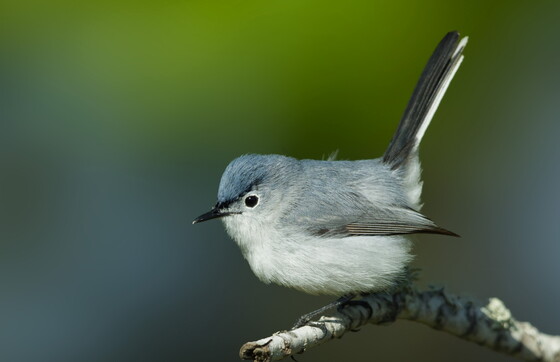 Blue-gray gnatcatcher (Ty Ivey/GNPA)
By TERRY W. JOHNSON
Each spring and fall, many birds pass through Georgia as they fly to or from their breeding grounds. In the spring, some of these migrants remain to raise their young.
Most of us know some of these species, such as summer tanagers, purple martins, ruby-throated hummingbirds and gray catbirds.
Yet there’s one summer resident that is found throughout our state but rarely seen by many Georgians. And most who do spot one of these birds don’t recognize it. …
Read Terry’s column for a behind-the-leaves look at blue-gray gnatcatchers.
Terry W. Johnson is a retired DNR manager and executive director of TERN, friends group of the Wildlife Conservation Section. Read past columns and his blog. Permission is required to reprint a column.
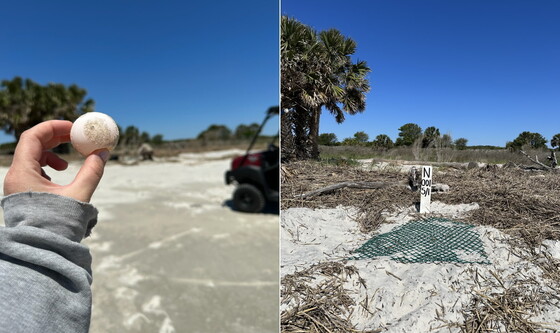 Egg for analysis from season's first loggerhead nest (right) on Blackbeard NWR (Kayla Reeves/USFWS)
Since the year’s first nest was found on Blackbeard Island National Wildlife Refuge, loggerhead sea turtles have shifted gears in Georgia. As of this week, more than 20 loggerhead nests had been marked, sampled and screened on six barrier islands. Following a record 4,071 nests in 2022, computer modeling points to a low to medium season this year for the state’s primary nesting sea turtle.
Hundreds of the pitcherplants rescued from a Charlton County mine site have found at home at Laura Walker State Park. Volunteers from the Georgia Native Plant Society’s Coastal Plain Chapter and DNR staff recently added 100 parrot and hooded pitcherplants to the bog, supplementing plantings done in 2021 and underscoring efforts by the Waycross park to manage the site.
 "Introducing the Indigo" video by Magic Kumquat Productions
A new video and companion coloring book are turning the attention of young and even old to eastern indigo snakes. “Save the Indigo” — a project led by The Longleaf Alliance and including DNR and other partners – and the booklet with prescribed fire mascot Burner Bob are focused on raising awareness of these federally threatened snakes, as well as gopher tortoises and longleaf pine habitats.
Did you know that only seven of Georgia’s 47 native snake species are venomous and only one (the copperhead) usually thrives in suburban areas? So if you spot a snake, chances are it’s not venomous, and whether it is or isn’t, here is helpful advice on what to do.
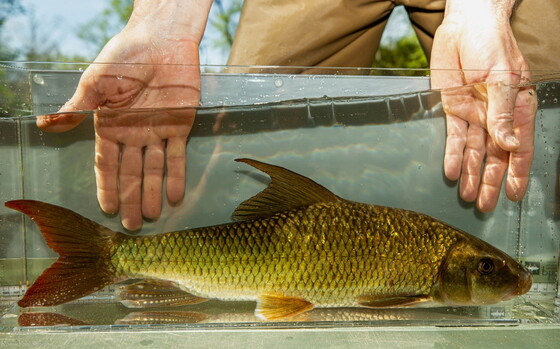 Sicklefin redhorse sampled on Brasstown Creek (Brett Albanese/DNR)
Sicklefin redhorse sampling this spring netted the most of these rare suckers – 45 – since 2017 at north Georgia’s Brasstown Creek. Each year, DNR and partners tag and release sicklefin redhorse migrating upstream to spawn in the Hiawassee River tributary to assess survival rates and the population’s size.
The Amazing Anhingas, a high school team from Glynn and DeKalb counties, claimed the Youth Birding Competition championship for the second straight year last month. The DNR birdathon aimed at getting youth outdoors and interested in birds drew more than 110 participants, about a third of them new to the event.
 Children enjoy a close look at wildlife at CoastFest (DNR)
Quick hits:
- Check out the fun and some of the more than 6,000 faces at CoastFest 2023.
- For more of the same but closer to Atlanta, don't miss this year's Keeping Georgia Wild Family Festival, set for May 20 at Charlie Elliott Wildlife Center near Mansfield.
- Genetic analysis continues with UGA to confirm if historic brook trout streams in north Georgia still have native brookies.
- When at the beach, give beach-nesting birds the space they need (and keep your dogs at home or on a leash).
- What not to do for bears: Don’t provide them easily available food – secure your trash.
- The annual Coastal Georgia Ecosystem Report Card gives our coast a B.
- DNR and other organizations recently shared news of outdoor options and activities with people using the Atlanta BeltLine.
- While neither ospreys nor owls nested at The Landings bird cam site this year, great blue herons are raising young nearby.
Names in the news: When angler Laura Cutter learned that Cathy Sanders had tied the Georgia record for Florida pompano Cutter had held since 1982, she reached out Sanders on Facebook and hired the surf-fishing guide for a fishing trip to celebrate Cutter’s 60th birthday. And, yes, they both caught keeper Florida pompanos. The Safari Club International’s Georgia Chapter named DNR Cpl. Brock Hoyt the Investigative Game Warden of the Year.
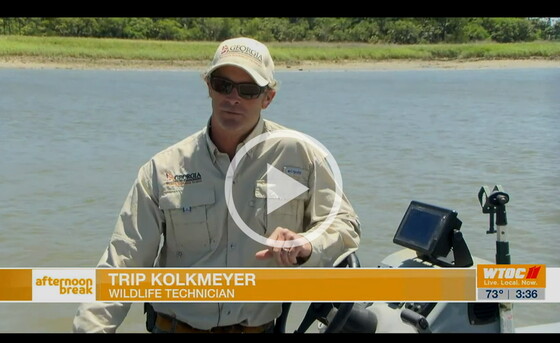 "Tracking Sammy G" (the manatee), WTOC-TV (ch. 11, Savannah)
"NOVA: Mystery of the Shrinking Right Whale Population," GBH News (Boston)
"This American Land: Saving Whales and Women Hikers," PBS
(+audio) "Georgia has big conservation goals; military helping to achieve them," WABE-FM (90.1, Atlanta)
"DNR's youth birding competition draws crowd," The Albany Herald and others
(+audio) "Georgia's bat populations crashing, but signs of hope emerge," Georgia Public Broadcasting
"Hope vs. rope: Can technology save whales and lobster industry?" Yahoo!news, via Portland (Maine) Press Herald. Related: "Scientists weigh in on right whale measures," Canadian Broadcasting Corp.
(+audio) "‘Everyone wants to find the first nest:' sea turtle nesting season begins," Georgia Public Broadcasting. Also: WJCL-TV (ch. 22, Savannah) and others.
"Waters roiled despite law to calm tensions between anglers, river landowners," Georgia Recorder
"Georgia's hedge against climate change: Okefenokee peat," The Current
"Armadillos on the move in Georgia," Axios Atlanta
(+video) "Composer transcribes bird songs," CBS News
"Be bearwise: What do to if you see a bear," Calhoun Times
"Coastal Georgia Ecosystem Report Card released," AllonGeorgia
(+video) "Cumberland’s wild horses might be removed after lawsuit filed," WFOX/WJAX-TV (chs. 30 and 47, Jacksonville, Fla.)
"DNR offers advice on snake sightings," Cherokee Tribune & Ledger-News (Canton)
"Want to explore nature? Top-rated trails in Macon area," Yahoo!news, via The (Macon) Telegraph
"Deal done on Fla. dollars targeting pythons, invasive species gap," Florida Politics
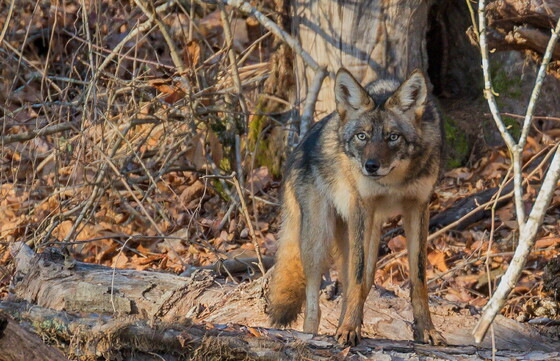 Coyote (Joe Berry)
’Hearing a big family of coyotes causing a commotion at night? Listen again. These tricky canines take advantage of what’s called the Beau Geste effect, an auditory illusion that can make a pair sound like seven or eight coyotes. The effect helps ’yotes communicate territories and create sound “boundaries” between them.
Wild Facts, by DNR's Ethan Hatchett, explores insights into Georgia wildlife.
Top
|